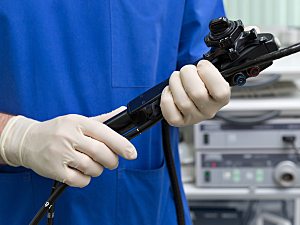One of the proposed mechanisms of weight loss after endoscopic sleeve gastroplasty (ESG) is prolonged satiety due to delayed gastric emptying.
Christopher C. Thompson, MD, director of endoscopy and co-director of the Center for Weight Management and Wellness at Brigham and Women’s Hospital, and colleagues are studying a novel bariatric and metabolic procedure to weaken the antral pump, a major physiologic component of gastric emptying. In Gastroenterology, they report on a pilot study of the procedure, gastroplasty with endoscopic myotomy (GEM), in which a pylorus-sparing antral myotomy is performed before traditional ESG, and found that GEM was technically feasible and safe.
GEM Procedure
GEM consists of three steps:
- Pylorus-sparing antral myotomy via a submucosal tunneling technique to weaken the antral pump and impede emptying
- A running suture at the level of the incisura to separate the antrum from the gastric body and minimize tension on the myotomy access site closure
- Standard ESG in the gastric body to reduce mixing and limit accommodation
A video accompanying the journal article demonstrates the GEM procedure.
Technical Feasibility
All patients underwent GEM successfully:
- Antral myotomy—A partial-thickness myotomy was performed in three patients and a full-thickness technique in the other three. The mean tunnel length was 9.0 cm, and the mean myotomy length was 7.7 cm. Mucosotomy sites were closed using a mean of one suture and eight stitches
- ESG—The mean numbers of sutures and stitches placed per sleeve were 8 and 50, respectively. After the procedure, the gastric length was shortened by a mean of 16.0 cm, a mean reduction from the baseline of 67%
The mean length of stay was 1.8 days.
Efficacy
Total weight loss was:
- 1 month—mean of 12% (P<0.0001)
- 3 months—mean of 15% (P<0.0001) and >10% in all patients
Safety
One patient was readmitted for nausea. At the one- and three-month follow-up visits, no patients endorsed upper gastrointestinal symptoms.
Mechanisms of Action
Before GEM, one patient (17%) had delayed gastric emptying (T1/2 of 204 minutes). Two weeks after GEM, that proportion had increased to 100% (P=0.02), and the mean T1/2 had increased from 90 to 204 minutes (P<0.0001).
The mean score on the postprandial fullness/early satiety subscale of the Gastroparesis Cardinal Symptom Index also increased significantly, from 0.2 to 1.0 (P=0.01).
Looking Ahead
Adding myotomy to ESG may mitigate the effects of suture loss and provide more predictable and durable outcomes. The Brigham team plans further physiologic-based studies of GEM.
